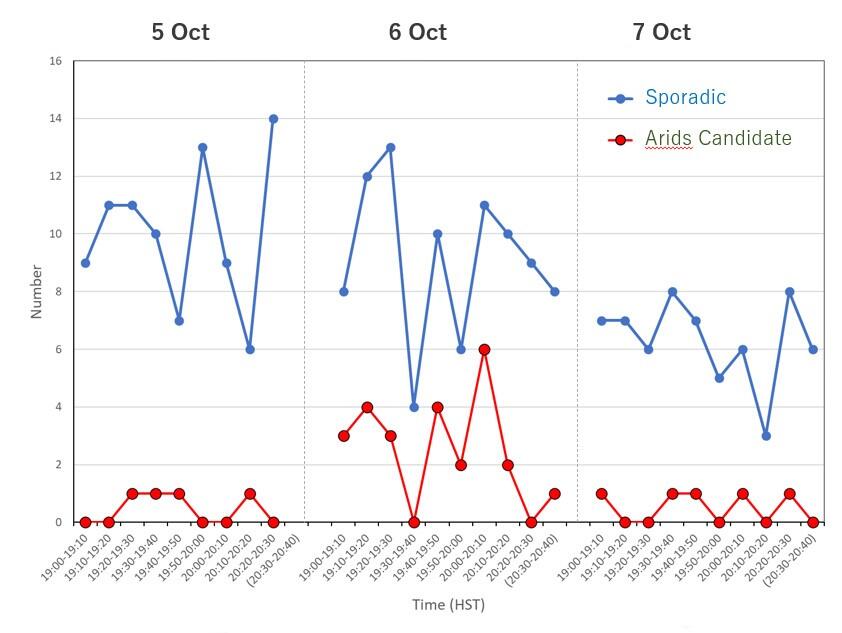Subaru Telescope's "Subaru-Asahi Star Camera" (Note 1) captured the activity of a newly-emerged meteor shower last fall. The meteor-shower activity was detected by volunteers who regularly enjoy the Subaru Telescope's Live Sky Camera.

Figure 1: The Arid meteor shower over the Maunakea Observatories. The short streaks flowing down from the upper right to the lower left are the meteors of the Arids. This is a composite of 24 meteors that appeared between 19:00 and 20:40 (Hawai`i Time) on October 6, 2021. Since the composite image is made of the frames only at the time of the meteors, the trails of stars due to diurnal motion are seen as series of dots. (Credit: National Astronomical Observatory of Japan, Asahi Shimbun)
The Emergence of an Arid Meteor Shower
Ara is a constellation in the southern sky, located to the south of Scorpius. Four researchers, including Mikiya Sato of the National Astronomical Observatory of Japan, predicted that a new meteor shower would appear from the direction of Ara on October 7, 2021 (UT). The source of that meteor shower activity is Comet 15/P Finley, which exhibited outburst activities in 2015.
According to the forecast, the peak activity of this new meteor shower was expected to be just after 3 p.m. on October 6 in Hawai`i time. Although the peak itself would not be observable from Maunakea, its trailing activities might still be visible in the evening sky. With this in mind, Sato turned his attention to the Live Sky Camera on the Subaru Telescope.
Launching A Citizen Science Project to "Find a NEW Meteor Shower!"
Upon receiving emails from Sato, Ichi Tanaka of Subaru Telescope, who manages the Subaru-Asahi Star Camera, also paid attention to the day's live video stream. Although a few viewers noted that they had an impression of increased activity of faint dark meteors, no clear meteor shower activity was seen, or so he thought. Later, he received a comment from Sato that the activity might have been detected in there. Intriguing, but the live video had already ended. It seemed as if this precious observation opportunity had been lost.
However, soon thereafter it was found that one of the viewers of the live streaming had kept the videos of three nights including before and after the meteor-shower day! This discovery made it possible to conduct follow-up verification. Sato and Tanaka launched a project to try to evaluate the occurrence of the meteor shower from the recorded data, with the cooperation of the viewers of Subaru-Asahi Star Camera.
Detection of the new Arid Meteor Shower
There were seven viewers (Note 2) who responded to the emergency call for volunteers. They were asked to carefully evaluate what could be potential candidates for meteor trails from the three days of data. After the data was summarized and cross-checked by Tanaka and Sato, the final count of the candidates for the Arids meteor shower was attained. The summarized data clearly showed that the number of meteors along the predicted path for Arids increased only on the night of the 6th (Figure 2)!

Figure 2: The number counts of the meteors which appeared during October 5-7 (19:00-20:40). The red circles indicate the number of candidates for the Arid meteor shower, and the blue circles indicate meteors with unrelated trajectories. A total of 24 meteor shower candidates were detected on October 6, while only four were detected on October 5 and 7. The counts are binned into 10 minute intervals. (Credit: NAOJ/Tanaka I.)
The observed Arid meteor candidates are characterized by their slow speed and faintness, as predicted, and are almost impossible to detect by visual observation. These 24 meteors were of ephemeral appearance and could only be detected by the highly sensitive cameras installed on Maunakea, one of the world's premier observing sites (Figure 1).
"I'm glad to see that the archived videos I have personally saved are being used in this way," says Watashi-meme (pseudonym), who provided the recorded data and helped with the meteor counts. "I was very impressed to see that the meteor shower activity actually appeared from our counts. It was a great opportunity to participate in the project with the other volunteers."
Sato, who issued the meteor shower forecast, said, "As a forecaster of the Arid meteor shower, I am very happy to be involved in the detection of this new meteor shower. The detection of the new meteor shower was the result of the efforts of citizen volunteers who spent a long time checking the images in detail. I would like to express my deepest gratitude."
The Arid meteor shower was registered as a new meteor shower by the International Meteor Organization (IMO) in October 2021. The few other visual observations of the Arids were mostly from sites in the southern sky, and so the results of Subaru-Asahi Star Camera, which captured meteor activity in the northern sky in the middle of the Pacific Ocean at a time when no other observations were available, provided a very valuable record of the activity of the Arids.
This result was reported at the Annual Spring Meeting of the Astronomical Society of Japan on March 3.
(Note 1) Subaru-Asahi Star Camera is a joint project of NAOJ Subaru Telescope and Asahi Shimbun. Please give credit to Subaru Telescope and Asahi Shimbun when using the material for news purposes.
(Note 2) The following seven people volunteered to participate in the meteor shower detection project. (In alphabetical order, pseudonyms are marked with " ".)
"Amahara-chan Back", "Kage-Tan", "Cookie", Hiroaki Suzuki, Harutaka Nagahata, Hiroshi Minagawa, and "Watashi-Meme".


